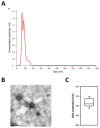Exosomes Derived from Human Induced Pluripotent Stem Cells Ameliorate the Aging of Skin Fibroblasts
- PMID: 29890746
- PMCID: PMC6032439
- DOI: 10.3390/ijms19061715
Exosomes Derived from Human Induced Pluripotent Stem Cells Ameliorate the Aging of Skin Fibroblasts
Abstract
Stem cells and their paracrine factors have emerged as a resource for regenerative medicine. Many studies have shown the beneficial effects of paracrine factors secreted from adult stem cells, such as exosomes, on skin aging. However, to date, few reports have demonstrated the use of exosomes derived from human pluripotent stem cells for the treatment of skin aging. In this study, we collected exosomes from the conditioned medium of human induced pluripotent stem cells (iPSCs) and investigated the effect on aged human dermal fibroblasts (HDFs). Cell proliferation and viability were determined by an MTT assay and cell migration capacity was shown by a scratch wound assay and a transwell migration assay. To induce photoaging and natural senescence, HDFs were irradiated by UVB (315 nm) and subcultured for over 30 passages, respectively. The expression level of certain mRNAs was evaluated by quantitative real-time PCR (qPCR). Senescence-associated-β-galactosidase (SA-β-Gal) activity was assessed as a marker of natural senescence. As a result, we found that exosomes derived from human iPSCs (iPSCs-Exo) stimulated the proliferation and migration of HDFs under normal conditions. Pretreatment with iPSCs-Exo inhibited the damages of HDFs and overexpression of matrix-degrading enzymes (MMP-1/3) caused by UVB irradiation. The iPSCs-Exo also increased the expression level of collagen type I in the photo-aged HDFs. In addition, we demonstrated that iPSCs-Exo significantly reduced the expression level of SA-β-Gal and MMP-1/3 and restored the collagen type I expression in senescent HDFs. Taken together, it is anticipated that these results suggest a therapeutic potential of iPSCs-Exo for the treatment of skin aging.
Keywords: exosomes; human induced pluripotent stem cells (iPSCs); photoaging; senescence; skin regeneration.
Conflict of interest statement
The authors declare no conflict of interest.
Figures









Similar articles
-
Derivation of Cell-Engineered Nanovesicles from Human Induced Pluripotent Stem Cells and Their Protective Effect on the Senescence of Dermal Fibroblasts.Int J Mol Sci. 2020 Jan 5;21(1):343. doi: 10.3390/ijms21010343. Int J Mol Sci. 2020. PMID: 31948013 Free PMC article.
-
Exosomes Secreted from Induced Pluripotent Stem Cell-Derived Mesenchymal Stem Cells Accelerate Skin Cell Proliferation.Int J Mol Sci. 2018 Oct 11;19(10):3119. doi: 10.3390/ijms19103119. Int J Mol Sci. 2018. PMID: 30314356 Free PMC article.
-
Antiphotoaging Effect of 3,5-Dicaffeoyl-epi-quinic Acid against UVA-Induced Skin Damage by Protecting Human Dermal Fibroblasts In Vitro.Int J Mol Sci. 2020 Oct 20;21(20):7756. doi: 10.3390/ijms21207756. Int J Mol Sci. 2020. PMID: 33092202 Free PMC article.
-
Exosomes in skin photoaging: biological functions and therapeutic opportunity.Cell Commun Signal. 2024 Jan 12;22(1):32. doi: 10.1186/s12964-023-01451-3. Cell Commun Signal. 2024. PMID: 38217034 Free PMC article. Review.
-
Human Induced Pluripotent Stem Cell-Derived Exosomes as a New Therapeutic Strategy for Various Diseases.Int J Mol Sci. 2021 Feb 10;22(4):1769. doi: 10.3390/ijms22041769. Int J Mol Sci. 2021. PMID: 33578948 Free PMC article. Review.
Cited by
-
Tridimensional cell culture of dermal fibroblasts promotes exosome-mediated secretion of extracellular matrix proteins.Sci Rep. 2022 Nov 17;12(1):19786. doi: 10.1038/s41598-022-23433-0. Sci Rep. 2022. PMID: 36396670 Free PMC article.
-
Stem cell- derived extracellular vesicles as new tools in regenerative medicine - Immunomodulatory role and future perspectives.Front Immunol. 2023 Jan 24;14:1120175. doi: 10.3389/fimmu.2023.1120175. eCollection 2023. Front Immunol. 2023. PMID: 36761725 Free PMC article. Review.
-
Anthocyanin from Lycium ruthenicum Murr. in the Qaidam Basin Alleviates Ultraviolet-Induced Apoptosis of Human Skin Fibroblasts by Regulating the Death Receptor Pathway.Clin Cosmet Investig Dermatol. 2022 Dec 29;15:2925-2932. doi: 10.2147/CCID.S388418. eCollection 2022. Clin Cosmet Investig Dermatol. 2022. PMID: 36601462 Free PMC article.
-
Precise Diabetic Wound Therapy: PLS Nanospheres Eliminate Senescent Cells via DPP4 Targeting and PARP1 Activation.Adv Sci (Weinh). 2022 Jan;9(1):e2104128. doi: 10.1002/advs.202104128. Epub 2021 Nov 5. Adv Sci (Weinh). 2022. PMID: 34738744 Free PMC article.
-
Exploring the landscape of extracellular vesicle application for skin and plastic surgery: A bibliometric analysis from 2003 to 2023.Skin Res Technol. 2024 Aug;30(8):e13879. doi: 10.1111/srt.13879. Skin Res Technol. 2024. PMID: 39081098 Free PMC article. Review.
References
-
- Helfrich Y.R., Sachs D.L., Voorhees J.J. Overview of skin aging and photoaging. Dermatol. Nurs. 2008;20:177–183. - PubMed
-
- Varani J. Fibroblast aging: intrinsic and extrinsic factors. Drug Discov. Today Ther. Strateg. 2010;7:65–70. doi: 10.1016/j.ddstr.2011.06.001. - DOI
-
- Poljšak B., Dahmane R.G., Godić A. Intrinsic skin aging: the role of oxidative stress. Acta Dermatovenerol. Alp. Pannonica Adriat. 2012;21:33–36. - PubMed
MeSH terms
Substances
LinkOut - more resources
Full Text Sources
Other Literature Sources
Medical
Research Materials

